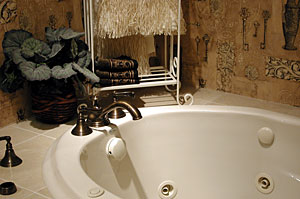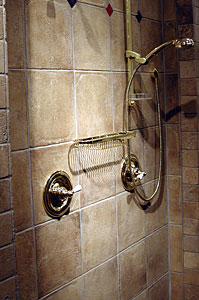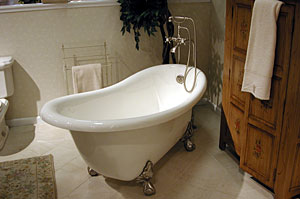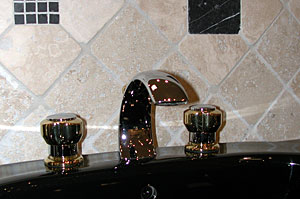| |
 |
 |
Build us a bathroom fit for a king and
queen,
Lifetime brass faucets, accents of rich royal green
Tumbled Tuscan marble and a whirlpool
for two,
An elongated toilet and French bidet too
A two-headed shower and seat would be
nice,
Complete with a niche for Champagne chilled on ice
|
When asking a salesman of reputable plumbing products what the real
differences were between one toilet and another, he replied facetiously,
"It really depends whether you like to flush a thousand-dollar toilet
or a hundred-dollar toilet." While there's more to the story than
that, his blunt remark had a trace of veracity.
Other than your kitchen, no other area of your remodeling or new
construction project will cost you more per square foot than your
bathroom. The cost range for these modern-day sanctuaries can be
staggering. A neighbor recently plunked down $25,000 for fixtures
and tile work alone. After figuring in the additional costs of framing,
sheetrock, electrical, heating, and finish work, our neighbor had spend
over $40,000 for a 120 square foot master bathroom boasting a cast iron
whirlpool tub, walk-in shower, double vanity, toilet and bidet. As you can
see the sky's the limit with bathrooms, but your budget usually forces you
back down to earth to keep costs from spiraling out of control.
Before you spend too much time day-dreaming about your bathroom, I
recommend getting out to several plumbing supply stores to calibrate
yourself on current costs. You'll find this to be a sobering experience.
Most retailers will gladly provide you with brochures. Ask to see their
master catalogs and the manufacturer's retail price lists as well. This
will give you a better idea of what you're up against in terms of prices.

For example, I was astonished to see that Kohler's old-fashioned style
bathtub (Birthday Bath) retailed for nearly $4,500 after accounting for
the required and recommended trim, faucets, and mounting hardware. By
comparison, a standard five-foot cast iron tub was only $500, a far cry
from $4,500. Similarly, a quality two-piece toilet in white lists for $200
- $400, while a sleek one-piece elongated color design from Kohler or
American Standard retails for $700 to $1,200 or more. A spacious vitreous
china pedestal sink in a subtle pastel color can cost from $500 to $1,000,
while a 24K gold-plated faucet can cost from $500 to $2,000. Imported
European brands such as KWC and Grohe can be even more pricey because of import fees, shipping,
and currency fluctuations, but their sleek styling and heavy-duty construction make them worthwhile choices. Don't forget to include tax, delivery charges,
and any discount your supplier might be willing to provide.
Depending on the dollar volume of your purchase, you can expect to
receive between 10-30% discounts on most fixtures. Some outlets prefer to
deal directly with your contractor who may pocket the savings himself. If
you feel confident enough to provide your own fixtures and can find a
retailer willing to give you a 25%-30% discount, you could save several
thousand dollars on a big job.
Choose Your Color Scheme
One of the first things you'll have to do is decide what color scheme
you plan to use for your bathroom. This can be difficult because your
vision of the final product may not be crystallized in your mind. Color is
important, however, since it affects price, availability, and may limit
your selection of other products such as tile, marble, paints, and
decorative trim. If your color scheme is unclear or dependent on too many
variables, I recommend going with white fixtures. White is most readily
available, most easily mixed and matched, most economical, and most likely
to stay in style for years to come. White is neutral and goes with
everything. Furthermore, accent colors on tiles, paints, towels, and
window treatments can give your bathroom the added appeal or dash of color
that you seek.
On the other hand, you may have some specific ideas on color schemes
that appeal to you. Perhaps you're looking to make a bold statement and
want to select black fixtures. Or, you want a subtle hint of rose to
soften an otherwise sterile white. Most leading manufacturers today offer
a wide range of color selections. Some have even teamed with accessory
manufacturers to provide complete color coordination, including tile,
wallpaper, and towels. Ask retailers for color samples of fixtures you're
considering. These come in handy when shopping for other elements of your
bathroom.
Be aware, however, that small color samples can be misleading. A whole
tub in dusty rose will likely appear darker than the color sample.
Remember that it only takes a hint of color to fool your eye. Choice of
color will always remain a personal issue. Keep in mind, however, that
colors come and go. You might consider sticking to subtle neutral colors
if there's a high likelihood that you'll have to resell the house in the
foreseeable future. Bold colors such as Emerald Green or Navy Blue may
look classy now, but in ten years they might look overstated and dated.
Remember what happen to Avocado green? Historically, white, ivory, almond,
and subtle grays and rose colors have always been popular. Unless your
urge to splurge gets the better part of you, stay away from bold reds,
pinks, yellows and blues or browns, except for rare circumstances where
your surrounding decor is particularly well suited.
Designer Fixtures

Some manufacturers now offer special-edition fixtures, such as American
Standard's Whisper series. While some of these patterns can be elegant and
subtle, others can be best characterized as fun, trendy, dazzling, and
bright. A zebra-skin look on your toilet might look funky today, but it'll
probably belong in the wild ten years from now. Due to their limited
appeal, the designer series also command a huge price premium -- sometimes
as much as 100% more than the same fixture in white. In no way is this
meant to criticize manufacturers for venturing creatively into new areas.
Ultimately, it's your bathroom and your choice. Do what makes sense for
you, but don't ignore the potential ramifications that might cause you to
replace your fixtures sooner than you wished.
Toilets and Bidets
The toilet or "WC" is, of course, one of most essential
elements of any bathroom. While the range of choices may seem too large to
digest, residential toilets basically fall into two common types: one
piece and two piece. When it comes to toilets, here are some basic facts
to consider.
A two-piece toilet consists of a tank and a bowl and is by far the most
common style on the market. Since a two-piece toilet is relatively easy to
manufacture, it costs less. Its economy and functional design have made
the "two-piece" America's predominant toilet. Since two-piece
designs rely on gravity flow to flush away organic contents, they can
sometime be a little noisy, although this is a matter of judgment,
particularly if you've grown accustomed to the flushing sound of a
two-piece toilet as most people have. In general, one-piece designs are
quieter because they use line pressure to flush away the contents rather
than pure gravity flow in the tank reservoir. Manufacturers boast that
one-piece designs are more hygienic, since dirt can't accumulate in the
seam between the tank and the bowl. If you clean regularly, this isn't a
big advantage in my opinion.
However, one-piece designs may require anywhere from 30 to 60 PSI to
operate satisfactorily, whereas two-piece designs work independently of
the available pressures. Low pressure can be a problem if the plumbing
supply is old, restricted, or too many fixtures are competing for water at
the same time, such as a flushing a toilet while running a shower. Typical
one-piece designs may require 1/2" supply lines compared to 3/8"
supplies for standard two-piece designs. If you go with a one piece
design, verify the proper supply size requirement and buy a recommended
tube that connects the valve stop to the toilet. Many plumbers overlook
this requirement leading to a toilet that operates unreliably.
Regardless of style, appearance can be boxy or elegant. Kohler's
Wellington two-piece toilet is very fashionable and sells for about half
the price of comparable one-piece designs. Eljer also makes a nice looking
two piece comparable in price to Kohler. As a general rule, Kohler offers
the widest range of colors, followed by American Standard. The better
brands are comparably priced with 5-10% of each other. When comparing
across brands, I like to compare the published list prices, then figure in
the discount offered for each brand. You can usually get 20% to 30%
discounts with little effort. Some high volume distributors such as
Pacific Sales in Southern California give even larger discounts. Shopping
around is always the best. You can do a lot of checking by phone and the
Internet, especially if you know what you want and deal with a person in a
position to negotiate prices. Also, don't overlook state and local sales
taxes, along with any shipping surcharges that some dealers apply.
If you haven't bought a new toilet in a while, it's important to
realize that many new designs have been engineered to operate with less
water. In an age when water is becoming a precious commodity, most newer
toilets operate with 3-1/2 gallons compared to 5 to 8 gallons for older
designs. In the past few years, even 1-1/2 gallon versions have emerged on
the market. Most retailers agree, however, that the jury is still out on
the 1-1/2 gallon versions. While they must meet certain standards, few of
the 1-1/2 gallon toilets appear to really work as well as advertised. If
you tend to be generous with your use of toilet paper, a
"toilet-lite" may become a bigger aggravation than it's worth.
Flushing twice doesn't save much water, is a nuisance, and may be the only
way to avoid sewage from clogging up your pipes. Before installing an
ultra low water usage toilet, I recommend that you discuss this issue
carefully with your contractor or plumbing supplier before you buy. They
can tell you what kind of maintenance problems they've seen on recent
installations.
The world's largest toilet and bidet manufacturer is Toto of
Japan. While this brand is less familiar in North America, Toto has
turned the art of toilet making into a science. Their toilets
feature an extra large passage chamber designed to reduce clogging, which
can be particularly problematic with the 1.6 gallon flush models just
mentioned. Although Toto does not make matching bathtubs, they do
manufacture a high quality line of pedestal sinks, toilets and bidets in a
handful of light neutral whites and beiges.
If you purchase your plumbing fixtures through your contractor or
plumber, you can expect them to keep some of the savings for their time
and effort. Never pay anything over list price, even if an item is
provided to you through a contractor. For budgeting purposes, find out the
list prices of the items you want and use that as your budget. Figure that
any discount you might get is just icing on the cake and will cover other
things that went over budget. Rarely do you come in under budget. There's
a natural tendency to want to upgrade as you get into your project, even
though you know you can't afford it.
If you live in cooler climates, you may notice periodic condensation on
your tank. The phenomenon is the same as when water condenses around the
bottom of a glass filled with a cold drink. The temperature differential
between the cold tank water and the warm indoor air causes water vapor to
condense on the tank, yielding a sweaty mildew that's both visually
unappealing and musty smelling. Sometimes the condensation is near the
bottom of the tank and may not be noticeable at first. If this is a
problem, ask your dealer for a tank insulator -- a plastic pouch that
lines your tank, helping to avoid large temperature differentials that
cause condensation.
Toilet Seats
If you're like me, you might be disappointed with the quality of the
standard toilet seats supplied with even some of the most expensive
toilets. Many of them simply feel flimsy and unsubstantial.
Several manufacturers such as Presalit make after-market toilet seats in
matching colors that are made of heavy-duty contoured laminates that not
only look elegant, but last forever.
|
|
|
 |
